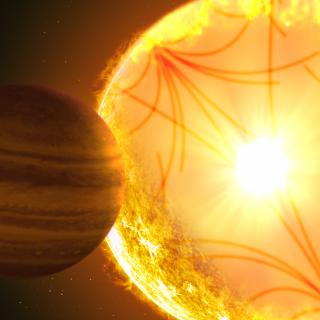Bibcode
Demangeon, O. D. S.; Cubillos, P. E.; Singh, V.; Wilson, T. G.; Carone, L.; Bekkelien, A.; Deline, A.; Ehrenreich, D.; Maxted, P. F. L.; Demory, B. -O.; Zingales, T.; Lendl, M.; Bonfanti, A.; Sousa, S. G.; Brandeker, A.; Alibert, Y.; Alonso, R.; Asquier, J.; Bárczy, T.; Navascues, D. Barrado; Barros, S. C. C.; Baumjohann, W.; Beck, M.; Beck, T.; Benz, W.; Billot, N.; Biondi, F.; Borsato, L.; Broeg, Ch.; Buder, M.; Cameron, A. Collier; Csizmadia, Sz.; Davies, M. B.; Deleuil, M.; Delrez, L.; Erikson, A.; Fortier, A.; Fossati, L.; Fridlund, M.; Gandolfi, D.; Gillon, M.; Güdel, M.; Günther, M. N.; Heitzmann, A.; Helling, Ch.; Hoyer, S.; Isaak, K. G.; Kiss, L. L.; Lam, K. W. F.; Laskar, J.; des Etangs, A. Lecavelier; Magrin, D.; Mecina, M.; Mordasini, Ch.; Nascimbeni, V.; Olofsson, G.; Ottensamer, R.; Pagano, I.; Pallé, E.; Peter, G.; Piotto, G.; Pollacco, D.; Queloz, D.; Ragazzoni, R.; Rando, N.; Rauer, H.; Ribas, I.; Rieder, M.; Salmon, S.; Santos, N. C.; Scandariato, G.; Ségransan, D.; Simon, A. E.; Smith, A. M. S.; Stalport, M.; Szabó, Gy. M.; Thomas, N.; Udry, S.; Van Grootel, V.; Venturini, J.; Villaver, E.; Walton, N. A.
Bibliographical reference
Astronomy and Astrophysics
Advertised on:
4
2024
Journal
Citations
14
Refereed citations
11
Description
Context. WASP-76 b has been a recurrent subject of study since the detection of a signature in high-resolution transit spectroscopy data indicating an asymmetry between the two limbs of the planet. The existence of this asymmetric signature has been confirmed by multiple studies, but its physical origin is still under debate. In addition, it contrasts with the absence of asymmetry reported in the infrared (IR) phase curve.
Aims: We provide a more comprehensive dataset of WASP-76 b with the goal of drawing a complete view of the physical processes at work in this atmosphere. In particular, we attempt to reconcile visible high-resolution transit spectroscopy data and IR broadband phase curves.
Methods: We gathered 3 phase curves, 20 occultations, and 6 transits for WASP-76 b in the visible with the CHEOPS space telescope. We also report the analysis of three unpublished sectors observed by the TESS space telescope (also in the visible), which represents 34 phase curves.
Results: WASP-76 b displays an occultation of 260 ± 11 and 152 ± 10 ppm in TESS and CHEOPS bandpasses respectively. Depending on the composition assumed for the atmosphere and the data reduction used for the IR data, we derived geometric albedo estimates that range from 0.05 ± 0.023 to 0.146 ± 0.013 and from <0.13 to 0.189 ± 0.017 in the CHEOPS and TESS bandpasses, respectively. As expected from the IR phase curves, a low-order model of the phase curves does not yield any detectable asymmetry in the visible either. However, an empirical model allowing for sharper phase curve variations offers a hint of a flux excess before the occultation, with an amplitude of ~40 ppm, an orbital offset of ~ −30°, and a width of ~20º. We also constrained the orbital eccentricity of WASP-76 b to a value lower than 0.0067, with a 99.7% confidence level. This result contradicts earlier proposed scenarios aimed at explaining the asymmetry observed in high-resolution transit spectroscopy.
Conclusions: In light of these findings, we hypothesise that WASP-76 b could have night-side clouds that extend predominantly towards its eastern limb. At this limb, the clouds would be associated with spherical droplets or spherically shaped aerosols of an unknown species, which would be responsible for a glory effect in the visible phase curves.
Aims: We provide a more comprehensive dataset of WASP-76 b with the goal of drawing a complete view of the physical processes at work in this atmosphere. In particular, we attempt to reconcile visible high-resolution transit spectroscopy data and IR broadband phase curves.
Methods: We gathered 3 phase curves, 20 occultations, and 6 transits for WASP-76 b in the visible with the CHEOPS space telescope. We also report the analysis of three unpublished sectors observed by the TESS space telescope (also in the visible), which represents 34 phase curves.
Results: WASP-76 b displays an occultation of 260 ± 11 and 152 ± 10 ppm in TESS and CHEOPS bandpasses respectively. Depending on the composition assumed for the atmosphere and the data reduction used for the IR data, we derived geometric albedo estimates that range from 0.05 ± 0.023 to 0.146 ± 0.013 and from <0.13 to 0.189 ± 0.017 in the CHEOPS and TESS bandpasses, respectively. As expected from the IR phase curves, a low-order model of the phase curves does not yield any detectable asymmetry in the visible either. However, an empirical model allowing for sharper phase curve variations offers a hint of a flux excess before the occultation, with an amplitude of ~40 ppm, an orbital offset of ~ −30°, and a width of ~20º. We also constrained the orbital eccentricity of WASP-76 b to a value lower than 0.0067, with a 99.7% confidence level. This result contradicts earlier proposed scenarios aimed at explaining the asymmetry observed in high-resolution transit spectroscopy.
Conclusions: In light of these findings, we hypothesise that WASP-76 b could have night-side clouds that extend predominantly towards its eastern limb. At this limb, the clouds would be associated with spherical droplets or spherically shaped aerosols of an unknown species, which would be responsible for a glory effect in the visible phase curves.
The CHEOPS raw and detrended photometric time-series data used in this paper are available at the CDS via anonymous ftp to cdsarc.cds.unistra.fr (ftp://130.79.128.5) or via https://cdsarc.cds.unistra.fr/viz-bin/cat/J/A+A/684/A27
This study uses CHEOPS data observed as part of the Guaranteed Time Observation (GTO) programmes CH_PR00009, CH_PR00016 and CH_PR00036.
Related projects

Helio and Astero-Seismology and Exoplanets Search
The principal objectives of this project are: 1) to study the structure and dynamics of the solar interior, 2) to extend this study to other stars, 3) to search for extrasolar planets using photometric methods (primarily by transits of their host stars) and their characterization (using radial velocity information) and 4) the study of the planetary
Savita
Mathur

Exoplanets and Astrobiology
The search for life in the universe has been driven by recent discoveries of planets around other stars (known as exoplanets), becoming one of the most active fields in modern astrophysics. The growing number of new exoplanets discovered in recent years and the recent advance on the study of their atmospheres are not only providing new valuable
Enric
Pallé Bago